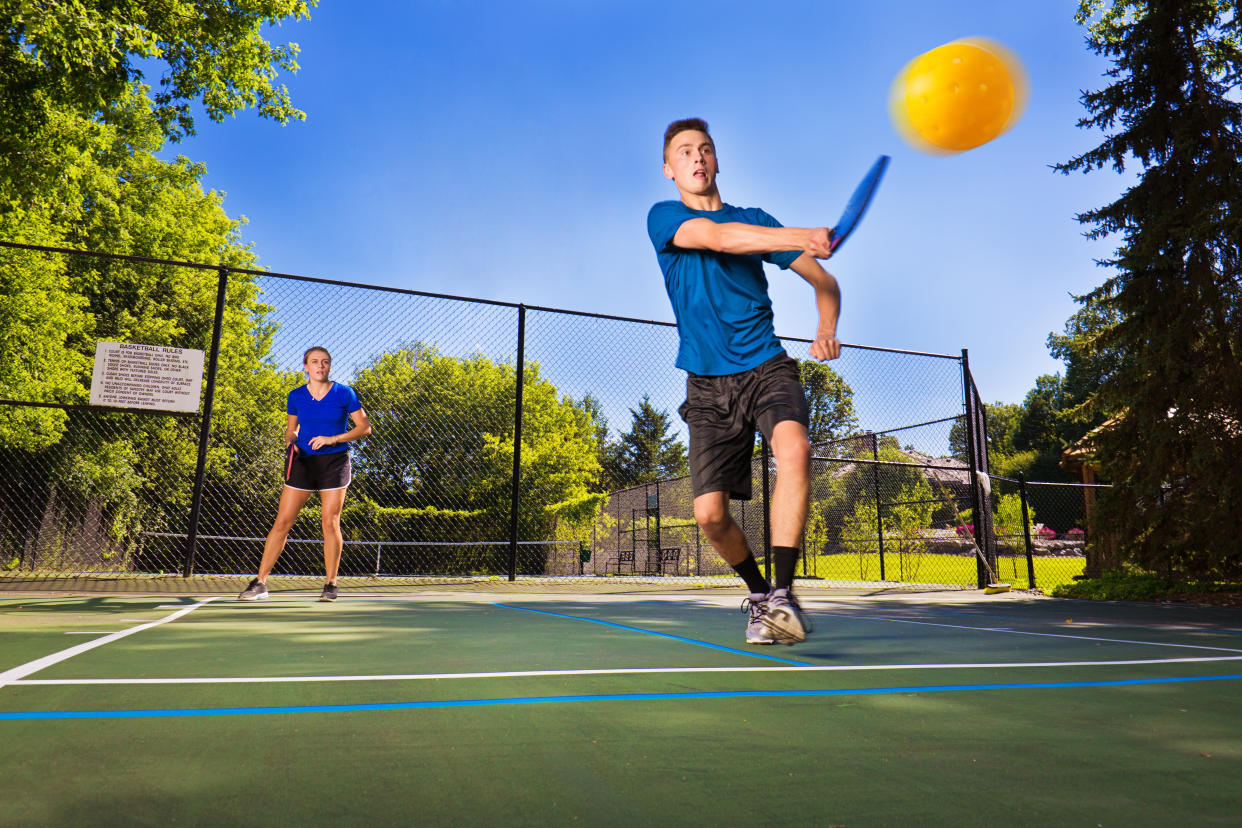Pickleball injuries happen. Here's how stretches, resistance training and the proper shoes can help you avoid them.

Pickleball is no longer the scrappy sport on the rise — it’s reached full-on superstar status. One of the most appealing parts of the sport (according to so-called picklers, who love to hit the 20-by-44-foot courts in pairs of doubles) is that it has a low barrier to entry. Unlike other racket sports like tennis, pickleball boasts simple rules, a slower ball and a small court — making it easy for beginners (and those of us who don’t consider ourselves exceedingly athletic) to catch on and keep up.
But just because pickleball may not be as intense as the sport at the center of Challengers doesn’t mean you can’t get hurt playing it. Like tennis, pickleball has been associated with a number of injuries that can take people out of the game — or, in extreme cases, even to the hospital. If you want to keep playing into your twilight years — as many people are currently doing — it’s important to know how to avoid them. Here’s what experts recommend.
What injuries are common with pickleball?
Since pickleball is a sport that many people can play daily if they choose, picklers run the risk of injuries related to overuse of certain joints and muscles, Dr. James B. Chen, an orthopedic surgeon and sports medicine expert at DISC Sports and Spine Center, tells Yahoo Life. These injuries include sprained ankles and tennis elbow (a painful condition caused by overuse of the elbow that leads to inflammation of the tendons on the outside of the elbow), as well as tendinitis around the knees, elbows and shoulders.
Chen notes that major injuries, such as ligament tears and fractures, are “thankfully less common.” However, they can occur, and typically result from “a fall or misstep during a period of overexertion.” Sports medicine physician Dr. Hallie Zwibel points to the fact that “the sport requires agility and rapid directional changes,” and that these moves can often “catch players off guard,” leading to unexpected injury.
How can we prevent pickleball injuries?
“Preventing pickleball injuries involves a mix of good preparation and smart playing habits,” says Zwibel. “Regular stretching — particularly focusing on the shoulders, hips and legs — can improve flexibility and reduce the risk of strains.”
He adds that incorporating strength and conditioning exercises into your routine can also “enhance your overall stability and endurance, making you less prone to injury.” It’s also important to warm up before play, which can make a big difference in your injury risk.
According to Sean Steerforth, a master flexologist with StretchLab, jumping jacks, jogging and “dynamic stretches like arm circles and leg swings” will help increase blood flow and flexibility before you enter the game.
However, it’s just as important to stretch after you play. “Perform static stretches for all major muscle groups to help reduce muscle stiffness and improve flexibility,” Steerforth notes. He also recommends assisted stretches, which “allows for deeper stretches than you might achieve on your own, improving flexibility in muscles and joints.”
One easy stretch Steerforth recommends for pickleball players? “Regularly stretch the forearm muscles by extending your arm with the palm facing down and gently pulling the fingers back with the other hand,” he says. “This reduces the risk of strain and inflammation from repetitive motions like gripping and backhand strokes in pickleball.” He adds that you can perform this stretch both before and after playing.
Resistance training can also help pickleballers avoid injury. Look into lifting weights, or doing squats with a resistance band, a few days a week.
The right shoes can help you avoid injury too
“Choosing the right footwear is crucial for pickleball safety,” says Zwibel. “For indoor play, court shoes with good lateral support and a nonmarking sole are ideal to provide the grip and stability needed on indoor surfaces.”
For outdoor play, Zwibel recommends shoes with a more durable sole and better traction to “handle varied and sometimes slippery surfaces.” However, regardless of the setting, he says it’s important to wear shoes with good ankle support and cushioning.
In the store searching for the right footwear? Jewels Busenberg, senior running and cycling footwear buyer for Zappos, recommends choosing a shoe with “a wide and high toe box to help prevent toe bruising,” which typically means there is “half an inch between your longest toe and the front of the shoe.”
Be aware of the heat
If you like to play pickleball outside, it’s also important to remember that the sun can cause issues of its own. That’s especially true in extreme heat.
“Playing pickleball in the sun can increase the risk of dehydration, sunburn and heat-related illnesses such as heat exhaustion or heatstroke,” says Chen. Be sure to apply sunscreen, hydrate and wear protective clothing. If you or anyone on the court displays symptoms of heat illness (such as a rash, headache, dizziness or nausea), stop playing and get to a shaded, cool area immediately.
With all these tips in mind, Chen says to remember that “there are major benefits of exercise, fresh air and social aspects that come with the sport — so get out there and have fun!”


